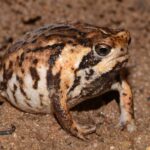Uncovering the Secrets of Arthroleptis nikeae: A Rare Jewel of Amphibian Biodiversity#
The forest floor is soft beneath footsteps, dampened by layers of fallen leaves and blanketed with droplets after last night’s rainfall. Shafts of sunlight filter softly through tangled branches, creating mosaics of warmth and shadow. It is here, within the pristine yet threatened forests of Tanzania, that an elusive inhabitant patiently waits, hidden in plain sight—a creature named Arthroleptis nikeae.
The Nike’s Squeaker—a common name reflecting its distinctive vocalizations—is more than just a small frog hidden among leaf litter. Scientifically known as Arthroleptis nikeae, this delicate amphibian encapsulates both the extraordinary adaptability of life to niche habitats and the vulnerability of ecosystems profoundly altered by human activities. First discovered and scientifically described in 2003, this species continues to enchant researchers and nature enthusiasts alike with its subtle beauty and enigmatic presence.
Yet, despite its charm, Arthroleptis nikeae remains largely unknown outside specialized circles. This article explores its fascinating biology, enchanting behaviors, ecological significance, and urgent conservation needs—painting a vibrant picture of why this diminutive yet crucial frog warrants our compassion and attention.
Taxonomy and Classification#
Placed taxonomically within one of amphibians’ more fascinating lineages, Arthroleptis nikeae belongs to the family Arthroleptidae, often termed “squeakers.” The genus Arthroleptis itself is home to a diverse group of small terrestrial frogs well-adapted to their specific ecological niches across Sub-Saharan Africa.
The name nikeae honors conservationist and biologist Nike Doggart for her tireless efforts toward East African conservation. Closely related to several other species within the genus, Arthroleptis nikeae showcases subtle distinctions in morphology and vocalization, which experts rely on for precise identification amid confusing similarities among its congeners.
Natural Habitat#
Geographical Range and Distribution#
It is deep in the richly biodiverse forests of Tanzania’s Eastern Arc Mountains where Arthroleptis nikeae has made its home. Specifically, populations have been recorded primarily within the forests of Udzungwa Mountains, a globally recognized biodiversity hotspot renowned for its high degree of endemism—species found nowhere else on Earth.
The Udzungwa landscape, cloaked in dense montane forests that cascade down lush slopes steeped in mist and mystery, provides the ideal microhabitats that these frogs require. To date, records suggest limited populations restricted to certain altitudinal gradients, typically between 1,000 and 2,200 meters above sea level.
Forest Floor Guardians#
Amid carpets of wet leaf litter—thick, humid caverns of fungi and decaying plant matter—Arthroleptis nikeae thrives. Equipped with subtle patterns perfectly matching the shifting hues of decomposition, the frog’s coloration plays a crucial role in camouflage, necessary for survival in ecosystems richly populated by predators.
The habitat provides essential moisture, form-fitting refuges under fallen timber and boulders, and an abundance of invertebrate prey. Microhabitats like these require a delicate climate balance—a fact making this species particularly sensitive to habitat fragmentation and climate shifts.
Physical Characteristics#
At first glance, the understated elegance of Arthroleptis nikeae belies its remarkable adaptation to the forest environment. Adults are typically no more than three centimeters long, compact yet graceful, easily nestled within your palm. Each individual bears sophisticated earth-toned hues—shades from ochre yellow to deep brown, flecked intricately with darker streaks and mottled patterns resembling speckled leaf litter.
The skin texture on their dorsal surface is subtly granular, enhancing camouflage and moisture retention. Their limbs, slender yet muscular, are ideally suited for navigating complex terrain—agile for delicate leaps across leaf-strewn floors when pursuing prey or evading predators. Their ventral surfaces are smoother, often pale cream or lightly speckled, providing a discreet counterbalance to their heavily camouflaged backs.
Adaptations for Survival#
Concealed coloration is more than cosmetic for Arthroleptis nikeae; it plays a pivotal role in avoiding detection by forest predators, such as birds, reptiles, and small mammals. In addition, these frogs exhibit cryptic behavior, remaining motionless when danger lurks nearby to rely upon their near-perfect disguise.
Despite being terrestrial, they have no webbing between their toes—functionally unnecessary given their terrestrial adaptations and preference for dense understory habitats rather than aquatic environments. Their reproductive biology further underscores their terrestrial specializations.
Behavior and Life Cycle#
Capturing Meals with Precision#
Emerging under cover of night and partial twilight, the Nike’s Squeaker demonstrates impressive foraging prowess amid leaf litter and decomposing vegetation. Its primary diet consists of minute invertebrates—ants, termites, beetles, spiders, mites, and other tiny arthropods—all crucial prey providing key nutrients to sustain their small yet energetically demanding form.
Equipped with sharp eyesight sensitive to movement at close range and highly tuned senses, these frogs perform swift leaps to capture prey skillfully, using their sticky, agile tongues to accurately seize their meals before predators can detect their position.
Mating, Eggs, and Direct Development#
During the wet season, when their forest home becomes drenched in cooling rains and resonant with choruses, males vocalize soft, cricket-like “squeaks,” an ecological symphony communicating territories and attracting mates. Remarkable for an amphibian, Arthroleptis nikeae bypasses the typical aquatic tadpole stage. Instead, eggs laid in damp soil, leaf litter, or beneath sheltered logs undergo direct development into miniature frogs entirely on land.
Scientists believe this terrestrial adaptation evolved in response to the unpredictability of standing water in rainforest ecosystems. By avoiding water bodies vulnerable to drying, predation, or pollution, this developmental strategy protects their offspring from several aquatic threats, offering ecological advantages at the expense of absolute reliance on stable, moisture-rich terrestrial habitat.
Ecological Role#
As an insectivore, Arthroleptis nikeae serves as a natural control agent for insect populations within forest habitats. Its presence provides key indicators of ecosystem health, as amphibians are among the first animals to be affected by environmental degradation, given their permeable skin and habitat specificities.
Additionally, this small frog plays a crucial role within its community food webs—both as predator and prey. Birds, small mammals, snakes, and other predators rely on healthy amphibian populations as important nutritional sources, making Arthroleptis nikeae a critical peg within its fragile ecological puzzle.
Threats and Conservation Status#
Currently listed as “Endangered” by the International Union for Conservation of Nature (IUCN), Arthroleptis nikeae faces considerable threats to its long-term survival. Habitat destruction through deforestation—primarily from logging, agricultural expansion, and encroachment by human settlements—remains one of the gravest danger facing this species.
Climate change-driven shifts in temperature and rainfall pose additional challenges, altering delicate moisture balances upon which this species inexorably depends. Such environmental fluctuations could dramatically limit available habitat and disrupt life cycles.
Current Conservation Efforts#
Fortunately, conservation measures are underway. Protective status has been afforded the Udzungwa Mountains, with various reserves and forests designated as conservation areas—efforts aided by local conservation initiatives raising awareness, research funding, and eco-tourism encouraging habitat protection.
Cultural and Scientific Significance#
Named in honor of conservationist Nike Doggart, Arthroleptis nikeae has inspired local pride and driven public recognition of amphibian biodiversity’s importance. Scientifically, the frog offers rich insights into evolutionary adaptations, ecological specialization, and provides essential data for understanding global amphibian declines, acting as a sentinel species for environmental health.
Conclusion#
Every quiet chirp from the leafy grounds of Tanzania whispers of balance, vulnerability, and hope. Safeguarding Arthroleptis nikeae requires proactive conservation, education, and passionate engagement by those enchanted with Earth’s astounding diversity. Our collective actions today determine whether future generations will find this diminutive amphibian hidden shyly amidst rainforest leaves—or merely echoes of a forest symphony forever silenced.
Let’s protect their habitat, ensure their legacy endures, and celebrate the vibrant tapestry woven by remarkable species like Arthroleptis nikeae.










